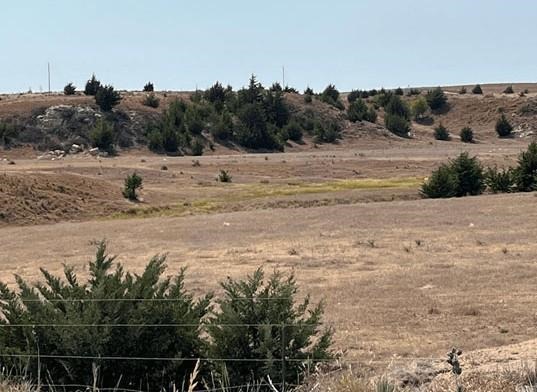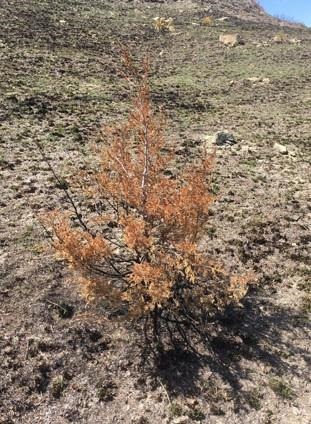By Keith Harmoney
Eastern redcedar (Juniperus virginiana) is the only evergreen tree native to Kansas, and it was originally found from eastern Canada, south to parts of Florida, and westward to eastern Texas and North Dakota. Before European settlement of the plains, it was believed to be found mainly in eastern Kansas on bluffs, ridges, and extremely steep slopes, or basically places that were difficult for fires to reach and travel through as prairie fires helped form the dominant grassland regions of Kansas.
Today, it has been introduced or has spread into most all regions of Kansas from shelterbelt introductions or from the lack of prescribed fires on pastures and rangelands into ecological sites where it originally did not occupy. It has adapted to most soils found throughout the state, from moist, deep loamy riparian soils to dry and clayey upland soils, but is especially adapted to dry, coarse, and calcareous soils.
Kansas has undergone a great spread of cedar trees over the last 50 years, and the expansion appears to be increasing rapidly. The Rangeland Analysis Platform (RAP) (https://rangelands.app/), a website that evaluates vegetation presence and production based on satellite imagery, shows that Kansas has seen a wave of expansion of trees and brush on areas that at one time were predominately grasslands. Tree cover on these grasslands has nearly doubled in the last 20 years, going from a cover of nearly 4% to just over 8% according to the RAP data.
Eastern redcedar is a major component of this wave of woody plant expansion. Even some upland pasture areas of watershed regions well west of the I-135/81 corridor showed a rapid expansion during this 20-year time period, so the encroachment of woody plants onto grasslands is no longer just an eastern Kansas occurrence (Fig. 1).

Figure 1. Eastern redcedar trees in a pasture 100 miles west of the I-135/81 corridor in Trego County, in August of 2022. The dark green trees stood out in the drought stricken and dormant brown grass that would typically be shades of green at that time of year.
The amount of accumulated forage lost over the years due to this woody expansion is staggering. The estimated amounts of annual forage from grasslands lost to tree expansion in just 2019 range from 0% in the western counties, to 1-7% in the central counties, and up to 30% in some eastern counties. The amount of estimated forage lost in each Kansas county, also called the grassland yield gap, can be viewed at https://www.wlfw.org/yieldgap/Kansas/index.html.
For instance, Stafford County, the center of which is nearly 80 miles west of I-135, lost just under 14 million pounds of forage in 2019 alone due to past tree expansion into its grasslands, equivalent to nearly 100,000 cow grazing days on rangeland at a moderate stocking rate. Decatur County, further north in the state and even further west, about 120 miles west of the I-135/81 corridor, lost nearly 3,000 cow grazing days to tree expansion during the same 2019 time frame. The number of lost grazing days will surely increase, even in western Kansas, without efforts to slow cedar expansion, and 2022 has shown us that grazing days are extremely valuable.
Eastern redcedar is a nonsprouting tree, meaning that it does not spread or propagate from its root system, even if the above ground part of the tree is killed or the trunk is cut off, but rather it is spread by trees being transplanted or by the release of seed into the landscape. Small, pea sized bluish green berries are produced only on female trees, and a single tree can produce thousands of berries, with each berry usually containing 1-3 seeds. A female tree will be able to produce berries by approximately 10 years of age. Meanwhile, male trees only produce pollen from small cones that look like bulged, dry leaf scales on leaf tips.
The sight of a single cedar tree in a pasture usually doesn’t result in rapid concern, but, knowing that a single female tree can produce thousands of seeds, the sight of this single tree means that many smaller trees could be establishing within the vicinity. This, of course, should raise concern that woody expansion is already well underway. Expansion usually occurs within 200 yards of the female tree, but birds and other wildlife may also carry the seed further distances. Cedar trees can often be seen establishing under powerlines, pasture fences, dead trees, and any other objects that serve as perches for birds that eat the berries.
Over time, these newly established seedlings can grow 1 foot per year or more, depending on rainfall and the soil where the trees are growing. Eventually, these trees develop enough canopy that the tree itself intercepts small amounts of precipitation, keeping it from reaching the soil, or uses moisture that does reach the soil that could otherwise have been used by grasslands for forage production. This tree canopy also produces shading, which further keeps the grasslands from converting sunlight into pasture forage.
The best way to stop woody tree expansion in Kansas pastures and rangelands is to prevent tree seedlings from establishing in the first place. A prescribed burning regimen, from a range of burning even once every 10-15 years in very western Kansas to once every 3 years in eastern Kansas, could significantly reduce the number of pastures with encroaching cedar trees. Pastures with enough fuel for a 10-mph wind to move the fire across the pasture is typically enough fuel to support a fire that can consume 3-4-foot-tall cedar trees (Fig. 2).

Figure 2. A 4-foot-tall cedar tree that was killed by the heat of a spring burn in Ellis County. Notice the dried leaves still on the tree, which indicates the fire did not consume and burn the tree in flames, but rather the heat of the fire was able to damage and kill the tree.
Otherwise, when first spotted as a small sapling, a small shears or tree snip can kill trees when cut at ground level. It’s much easier to kill and remove trees through burning or cutting when very small rather than prolonging management of the trees until later years. For trees that are 4 foot tall or larger, cutting the tree off below the lowest branch with a chain saw or other motorized shear also will kill the tree, but pastures may need to be burned or trees may need to be stacked and burned in order to reduce creating perches for birds.
When the above ground parts of the tree are killed by fire or cutting, the below ground portions will also die because the tree doesn’t have sprouting buds below the soil surface. Once an area is cedar tree free, be diligent in keeping the area tree free and incrementally expand the tree free zone to include surrounding lands. Areas near established cedar shelterbelts and prior existing high populations of trees will need extra attention as viable seed could be lingering in those areas for years.
During drought years, rangeland grasses may stop growing, turn brown, and go dormant during the usual growing season. However, cedar trees are highly capable of capturing soil water from great distances and often stay green during drought. In a summer such as 2022, encroaching cedar trees were often more evident, with their dark green color contrasting with dormant grass in pastures. A sobering yet one of the few positive outcomes of this past dry season is that it should have helped indicate pastures that need attention for some form of cedar tree control. Once cedar trees have been significantly reduced or eliminated in a pasture, be vigilant in continuing to control these trees and keep them from robbing rangeland grasses of the sunlight and water they need for growth. In a summer drought such as 2022, and in drought years to come, our pasture grasses can use every drop of water they can get.
Source : ksu.edu